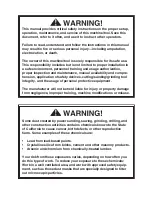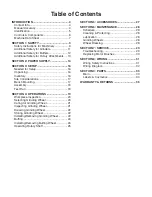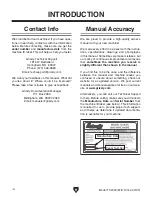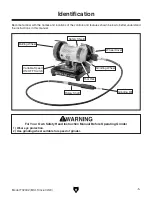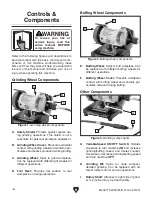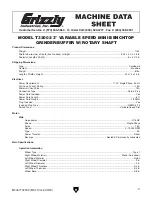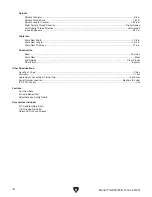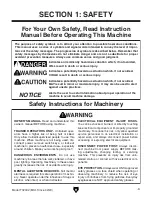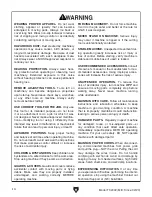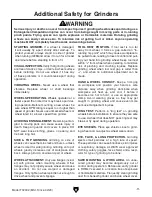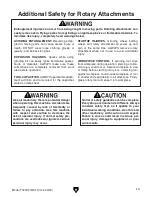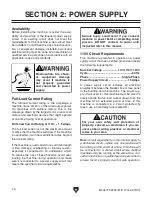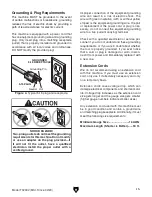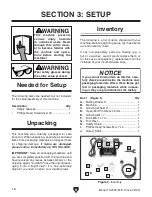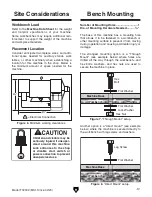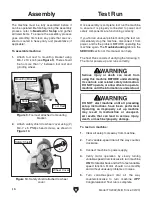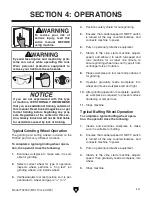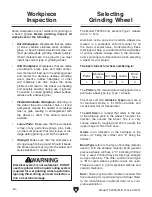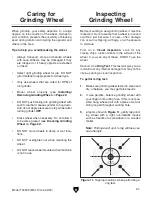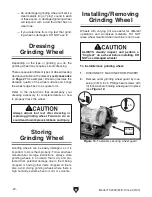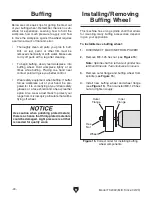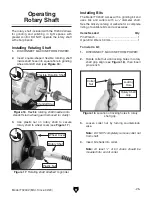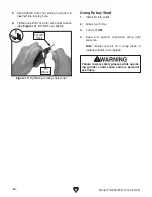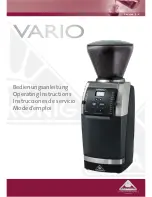
Model T32002 (Mfd. Since 02/20)
-11-
Additional Safety for Grinders
Serious injury or death can occur from impact injuries if grinding wheel breaks apart during use.
Entanglement/amputation injuries can occur from being caught in moving parts or in-running
pinch points. Flying sparks can ignite explosive or flammable materials. Rotating grinding
wheels can easily remove skin. To minimize risk of getting hurt or killed, anyone operating
machine MUST completely heed hazards and warnings below.
STARTING GRINDER. If a wheel is damaged,
it will usually fly apart shortly after start-up. To
protect yourself, always stand to side of grinder
when turning it
ON and allow it to run for at least
one minute before standing in front of it.
VISUAL INSPECTION. Verify that grinding wheels
are free of cracks, chips, or dents in wheel surface
before installing. Do not use wheel if it has any
of these problems or it could break apart during
operation.
VIBRATING WHEEL. Never use a wheel that
vibrates. Replace wheel or shaft bearings
immediately.
WHEEL SPEED RATING. Wheels operated at a
faster speed than rated for may break apart dur-
ing operation. Before mounting a new wheel, be
sure wheel RPM rating is equal to or higher than
speed of grinder. Never use unmarked wheels or
wheel rated for a lower speed than grinder.
AVOIDING ENTANGLEMENT. Becoming entan-
gled in moving parts can cause severe injury or
death. Keep all guards and covers in place; DO
NOT wear loose clothing, gloves, or jewelry; and
tie back long hair.
SIDE & TOP GRINDING. Grinding on side of
wheels can cause them to crack and burst—unless
wheel is rated for side grinding. Grinding on top of
wheels greatly increases risk of workpiece kick-
back. Always grind on downward part of wheel.
WHEEL ATTACHMENT. Only use flanges includ-
ed with grinder when mounting wheels. Other
flanges may not properly secure wheel and cause
an accident. Do not use warped or damaged
flanges. Only tighten wheel spindle nut enough to
drive wheel and prevent slippage.
TOOL REST POSITION. If tool rest is too far
away from wheel, it forms a gap called an "in-
running nip point" which may cause workpiece to
be pulled down, leading to loss of control and pull-
ing your hand into grinding wheel. Keep tool rest
within
1
⁄
8
" from wheel when operating to minimize
risk of pinching and crushing injuries. Replace
grinding wheel when tool rest gap is wider than
1
⁄
8
", and when no additional adjustment can be
made.
HAND & WHEEL CONTACT. Keep a firm grip
on workpiece and position your hands a safe
distance away when grinding. Anticipate when
workpiece will heat up, and cool it before it
becomes too hot to hold, or use an appropriate
clamp. Avoid wearing gloves as they may get
caught in grinding wheel and cause even more
serious entanglement injuries.
RING TEST. Perform a "ring test" on grinding
wheels before installation to ensure they are safe
to use. A wheel that does NOT pass ring test may
break or fly apart during operation.
EYE SHIELDS. Place eye shields close to grind-
ing wheel and re-adjust as wheel wears down.
EYE, FACE, & LUNG PROTECTION. Grinding
ejects small particles at a high rate of speed.
These particles can cause blindness, skin injuries
or respiratory damage. ALWAYS wear approved
clothing, safety goggles, face shield, and a respi-
rator for type of grinding to be done.
SAFE MOUNTING & WORK AREA. An unse-
cured grinder may become dangerously out of
control during operation. Before use, verify grinder
is FIRMLY secured in a location free of explosive
or flammable materials. Frequently clean grinding
dust from beneath grinder and inside wheel cover.
Summary of Contents for T32002
Page 36: ......


